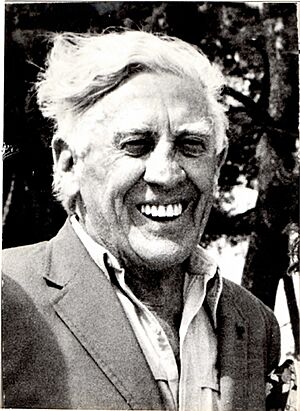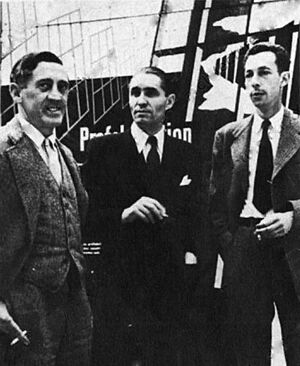Paul Nelson (architect) facts for kids
Quick facts for kids
Paul Nelson
|
|
|---|---|
 |
|
| Born | November 8, 1895 |
| Died | 1979 (aged 83–84) |
| Nationality | French |
| Occupation | Architect |
| Known for | Modern Architecture |
Paul Nelson (born November 8, 1895 – died 1979) was an architect. He was born in America but later became a French citizen. He is known for his modern designs.
Contents
Early Life and Education
Paul Nelson was born in Chicago, Illinois, USA. His family was from Ireland. He studied at Princeton University from 1913 to 1917. In 1917, he joined the Lafayette Escadrille. This was a group of American volunteer pilots who flew for France during World War I.
After the war, Nelson returned to America. He first worked at a bank. Then, he worked for his father's company, which decorated homes.
Moving to Paris and Family
In 1920, Paul Nelson moved to Paris, France. He continued his architecture studies there. He learned at the École Nationale Supérieure des Beaux-Arts. His teachers included famous architects like Emmanuel Pontremoli and Auguste Perret.
He married a French woman named Francine Le Cœur. Her father, François Le Cœur, was also an architect and a teacher in Paris.
In 1927, Nelson became a certified architect in France. He lived in Varengeville-sur-Mer. This was a place where famous artists like Claude Monet had worked.
Friends and Artists
Paul Nelson had many famous friends. These included writers like Ernest Hemingway and Francis Scott Fitzgerald. He also knew many artists. Some of these were Georges Braque, Joan Miró, Pablo Picasso, and Alexander Calder.
World War II and Later Career
During World War II, Nelson went back to the United States. He led a group called "France for ever." This group helped share French culture with Americans.
In 1944, he worked for the French government in Washington. He was in charge of construction and city planning. The next year, he became an advisor to the French Ministry of Reconstruction. He also advised the French Ministry of Public Health. He helped organize an exhibition in Paris about American building methods.
Family and Teaching
Paul Nelson's first wife, Francine, passed away in 1951. A year later, he married Madd Giannattasio. She was a painter. They had two sons, Ugo and Rory. Ugo became an architect, and Rory became a musician.
Nelson taught at many top American universities. In 1963, he became a director at the École Nationale Supérieure des Beaux-Arts in Paris. From 1967 to 1977, he also led a special architecture workshop in Marseille.
In 1973, Paul Nelson officially became a French citizen. He died in 1979. He was buried in Varengeville-sur-Mer. His wife Madd and his friend, the painter Georges Braque, are also buried nearby.
Architectural Works and Ideas
Paul Nelson was very interested in how spaces were designed. He also liked using parts that were built in factories (prefabrication). He became an expert in designing hospitals. This was the topic of his main study.
Early Projects
One of Nelson's first projects was a home in Paris for an American writer in 1929. In 1930, he designed the sets for a movie called What a Widow!
In 1932, Nelson created a plan for a new hospital in Lille, France. It was a very modern design. However, it was not built because he was a foreign architect.
In 1934, Nelson designed a surgical building for a hospital in Ismailia, Egypt. He made the operating rooms egg-shaped. They had glass floors and walls. His ideas were praised, but the hospital was built using older designs.
From 1936 to 1938, Nelson worked on a "suspended house." This house showed how strong steel construction could be. He worked with artists like Jean Arp and Fernand Léger on this project.
Post-War Contributions
After World War II, Nelson worked on his most important project. This was the Centre Hospitalier Mémorial France - États-Unis in Saint-Lô, France. The United States helped build this hospital. It was designed and built between 1946 and 1956.
In 1946, he also worked with artist Alberto Giacometti on a memorial.
Nelson helped with a project to rebuild Noisy-le-Sec. He designed three modern buildings there from 1950 to 1953.
In 1955, Nelson submitted a design for the Musée national Fernand Léger in Biot. His design was not chosen for the museum.
Between 1967 and 1977, Nelson designed several other hospitals. These included the Policlinique François I in Le Havre, and hospitals in Dinan and Arles.


